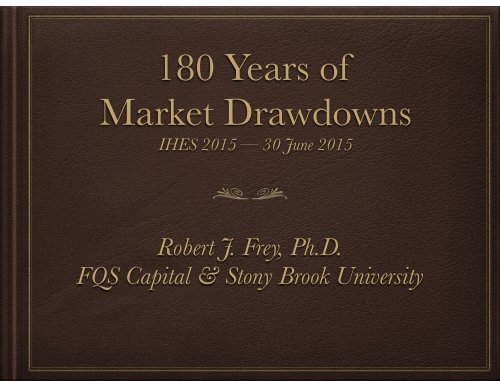Market Drawdowns
1rh4SCX
1rh4SCX
Create successful ePaper yourself
Turn your PDF publications into a flip-book with our unique Google optimized e-Paper software.
180 Years of<br />
<strong>Market</strong> <strong>Drawdowns</strong><br />
IHES 2015 — 30 June 2015<br />
Robert J. Frey, Ph.D.<br />
FQS Capital & Stony Brook University
Bio<br />
Worked as Systems Engineer and Program Manager in Defense Industry.<br />
Ph.D. in Applied Mathematics, Stony Brook University.<br />
Recruited into Morgan Stanley’s APT (Pairs Trading) Group in mid-80s.<br />
Started Kepler Financial in 1989; Kepler acquired by Renaissance in 1992.<br />
Managing Director with Renaissance; Developed Nova and Equimetrics Funds which<br />
were subsequently absorbed into Medallion. Retired in 2004.<br />
Former Advisory Board Chair of the University of Chicago’s Program on Financial<br />
Mathematics.<br />
Founder and Co-Director, Program in Quantitative Finance, Applied Mathematics and<br />
Statistics, Stony Brook University.<br />
FQS Capital, Investment Manager and Consulting Services, out-growth of Family Office.<br />
2
Myopia<br />
Day-to-day details<br />
overwhelm us narrowing<br />
our focus.<br />
Frequently, relatively<br />
simple models with<br />
longer horizons yield<br />
very useful insights.<br />
You don’t design a house<br />
based on the weather<br />
report.<br />
Source: http://keplerianfinance.com/2013/06/the-relevance-of-history/<br />
3
<strong>Market</strong> <strong>Drawdowns</strong><br />
An investment’s drawdown behavior is an important element<br />
of its behavior.<br />
We will focus on a single market: the S&P 500 Total Return<br />
from 1835 to 2015 (Global Financial Data).<br />
Important questions:<br />
How can drawdowns be modeled and analyzed?<br />
How stable is this aspect of performance?<br />
What insights can we develop examining the drawdowns in<br />
an important market over an extended period?<br />
4
<strong>Drawdowns</strong><br />
Cumulative log returns:<br />
t<br />
⎧<br />
c = ⎨c(t) = ∑ log[W s<br />
/W s−1<br />
]<br />
⎩ s=1<br />
t ∈1,…, T<br />
⎫<br />
⎬<br />
⎭<br />
Drawdown state:<br />
d = { d(t) = max ⎡<br />
⎣<br />
0,max ⎡⎣ c(s) s ∈{1,…, t} ⎤ ⎦ − c(t) ⎤<br />
⎦<br />
t ∈1,…, T }<br />
5
<strong>Drawdowns</strong><br />
Drawdown partition:<br />
δ = { δ i<br />
= { d(t i−1<br />
+1),…,d(t i<br />
)} i<br />
∀d(t) ∈δ i<br />
,(d(t) = 0) ∨ (d(t) > 0) }<br />
Drawdown process:<br />
D =<br />
⎧<br />
⎪⎛<br />
⎨⎜<br />
⎩⎪ ⎝<br />
Δ 1<br />
= max[δ 1<br />
]<br />
τ 1<br />
= t 1<br />
⎞ ⎛<br />
⎟ ,… Δ i<br />
= max[δ i<br />
]<br />
⎜<br />
⎠ ⎝ τ i<br />
= t i<br />
− t i−1<br />
+1<br />
⎞ ⎫<br />
⎪<br />
⎟ ,… ⎬<br />
⎠ ⎭⎪<br />
6
Full Dataset<br />
1835-2015<br />
7
8
9
10
One spends about 75% in a<br />
drawdown state.<br />
And more than half the<br />
time in a major drawdown.<br />
11
12
Max Drawdown Distribution<br />
Gamma-Exponential Mixture:<br />
∞<br />
∫0<br />
⎛<br />
⎝<br />
⎜<br />
e −λ/β β −α λ −(1+α ) ⎞<br />
Γ α ⎠<br />
⎟<br />
[ ]<br />
( λe −λx<br />
)dλ<br />
Variant of a Pareto Distribution (Lomax)<br />
f [Δ] = αβ(1+ βΔ) −(1+α )<br />
F[Δ] = 1− (1+ βΔ) −α<br />
13
14
Gaussian<br />
Simulation<br />
15
16
17
18
19
Stable<br />
Simulation<br />
20
21
22
23
24
Pre Great Depression<br />
1835-1928<br />
25
26
27
28
Post World War II<br />
1950-2015<br />
29
30
31
32
Comparisons<br />
33
34
35
Comparing <strong>Drawdowns</strong><br />
The basic character of the max drawdown<br />
process is reasonably similar across time.<br />
The recent period does show slightly lower<br />
incidence of larger drawdowns.<br />
36
Conclusions<br />
37
Conclusions<br />
<strong>Market</strong> drawdowns, as a driver of “regret” may play a greater role than we<br />
realize.<br />
The character of the market over the past 180 years does not seem to have<br />
changed greatly.<br />
A realistic statistical model awaits. We are unable to adequately model<br />
returns to reproduce the observed market.<br />
It would be a mistake to view the Great Depression as an “outlier”.<br />
Taking the long historical view provides insights that are valid today.<br />
Any study such as this suffers from survivor bias and the fact that we are<br />
likely to have underestimated our α exponents.<br />
38
Thank You<br />
39


